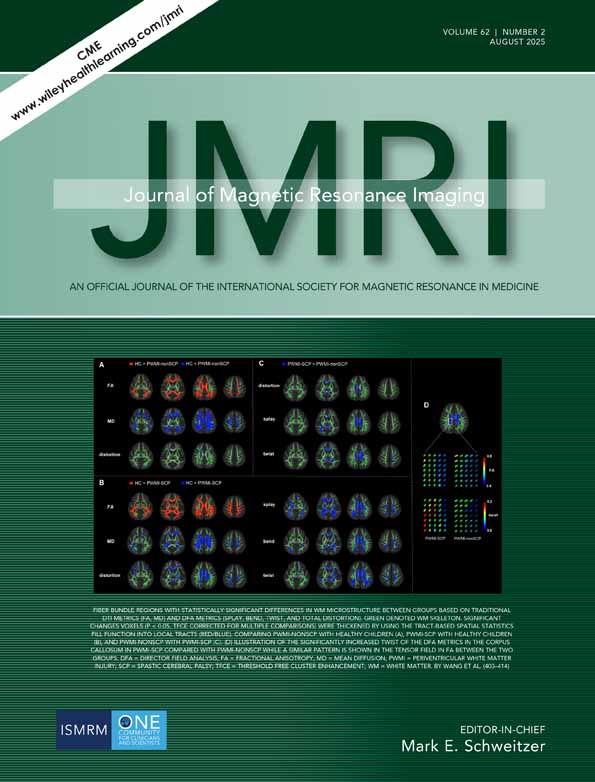MRI Assessment of Geometric Microstructural Changes of White Matter in Infants With Periventricular White Matter Injury and Spastic Cerebral Palsy
Miaoyan Wang, Hua Zhu, and Tingting Huang contributed equally to this work.
Abstract
Background
Periventricular white matter injury (PWMI) is a high-risk factor for spastic cerebral palsy (SCP).
Purpose
To investigate the geometric microstructural changes in WM in infants with PWMI-SCP using MRI which may facilitate early identification.
Study Type
Retrospective cohort study.
Population
Twenty-three healthy infants (aged 6.53–36 months), 25 infants with PWMI-SCP (aged 6–33 months), and 32 infants with PWMI-nonSCP (aged 6–36 months).
Field Strength/Sequence
3.0 T, T1-weighted three-dimensional gradient-echo sequence, and diffusion tensor imaging (DTI) with a single-shot gradient echo planar sequence.
Assessment
The brain was automatically segmented, parcellated into major regions of interest according to the Desikan–Killiany atlas and volumes extracted. Fractional anisotropy (FA) and mean diffusivity (MD) of regions were extracted from DTI data. Director field analysis (DFA) was used to assess the geometric microstructural properties of WM. Motor dysfunction was graded from l (mild) to 5 (severe) according to the Gross Motor Function Classification System.
Statistical Tests
Tests included analysis of variance, correlation analysis, mediation analysis, and receiver operating characteristic analysis. Corrected P-values <0.05 were considered significant. Mediation analysis examined whether DFA metrics mediated the relationship between brain morphological and motor dysfunction. Models were constructed to identify PWMI-SCP.
Results
The PWMI-SCP group exhibited significantly elevated all four DFA metrics (splay, bend, twist, and distortion), primarily in the corpus callosum, posterior thalamic radiata, and corona radiata, compared to the PWMI-nonSCP group, and was associated with enlarged lateral ventricles, reduced deep nuclear volumes and motor dysfunction. Mediation analysis indicated that increased splay in the corpus callosum partially mediates (mediating effect ratio: 29.74%, 22.46%) the relationship between the lateral ventricles and motor function. The results showed that DFA achieved a higher area under the curve (AUC) than the FA + MD, especially in distinguishing PWMI-nonSCP from PWMI-SCP (AUC = 0.93).
Data Conclusion
Monitoring fiber-orientational alterations may provide new insights into early identification of PWMI-SCP.
Plain Language Summary
This study utilized directional field analysis (DFA) to systematically examine white matter microstructural changes in three groups: periventricular white matter injury with spastic cerebral palsy (PWMI-SCP), periventricular white matter injury without spastic cerebral palsy (PWMI-nonSCP), and healthy controls. The results revealed significantly abnormal increases in the white matter geometric structure within the sensorimotor circuit in the PWMI-SCP group. DFA metrics achieved an AUC of 0.93 in distinguishing PWMI-SCP from PWMI-nonSCP. These specific microstructural changes provide critical insights for the early identification of PWMI-SCP.
Level of Evidence
3
Technical Efficacy
Stage 2
Conflict of Interest
Nothing to report.
Open Research
Data Availability Statement
The data that support the findings of this study are available on request from the corresponding author.




